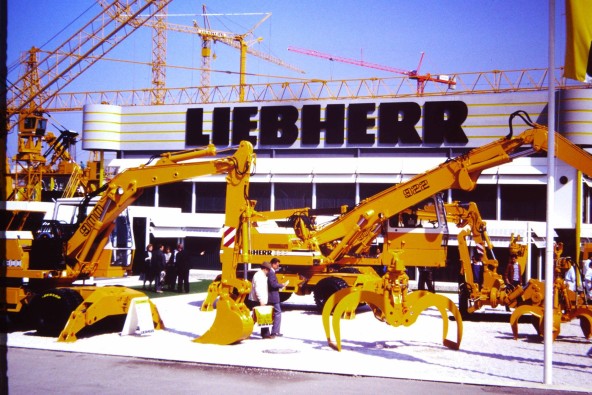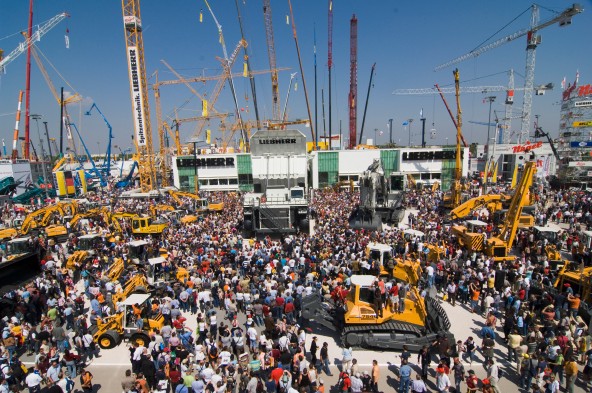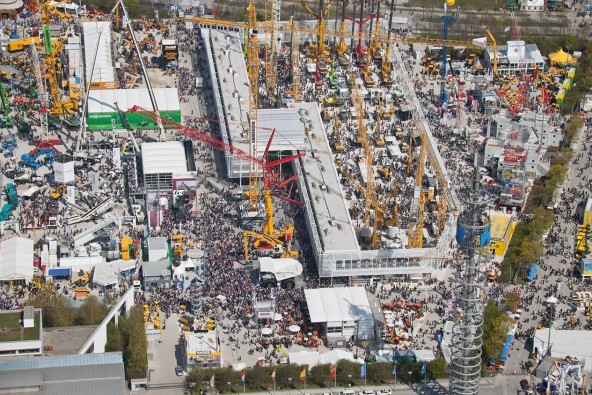Since 1956 – Liebherr at the Bauma in Munich
A lot has changed since Bauma began in 1954. Liebherr participated as one of the largest exhibitors at the second official Bauma in 1956. A few years later, in 1983, Klaus Eckert, now Head of Sales Promotion at Liebherr, was able to witness the construction of the Liebherr booth for the first time with his father. This was a very special experience at the time, as his father was responsible for the advertising for the entire Group. Klaus Eckert has now been organising exhibition appearances for Liebherr himself for many years and knows almost everything about Bauma and its history. Together, we take a look at what has changed, but also at what has remained the same at Bauma to this day.
Bauma has evolved considerably since it was first held in 1954. Originally starting as a small regional exhibition, it has grown into a global trade show that now takes place every three years in Munich. Klaus Eckert remembers his first years at the trade show: ‘Back then, Bauma was still held on the Theresienwiese in the centre of Munich. Everything was much more manageable, but also more cramped.’ Exhibit after exhibit was lined up and visitors found it difficult to reach the show ground.
Klaus Eckert looks back fondly on his first years at Bauma adding that then as now, he was proud to welcome visitors to the largest and, for him, most appealing booth at the trade show. The way of working has changed considerably since then, he continues – it has become more professional:
In the past, we used to improvise a lot on site. Sometimes someone had to run out and buy something at the last minute from the DIY store round the corner. Today, everything is much more coordinated – the entire booth is planned in CAD, right down to the door handle.

Bauma 1989
New show ground and modern booth concepts
In 1998, Bauma moved to the Messe München exhibition centre in Riem, where it is still held today. Klaus Eckert remembers the chaos with the traffic in the first year: ‘The underground railway should have been completed by 1998 and bring millions of visitors to the new show ground. However, as a section above the tunnel collapsed during the construction of the underground railway in 1994, there were massive delays and traffic chaos reigned at the first Bauma on the new site.’ Although the new site was much larger than the Theresienwiese – which by the end was bursting at the seams – the number of exhibitors also increased steadily and the booths themselves became ever more impressive.
The booth concepts have also changed considerably since the early days, becoming more unusual and well thought-out. Liebherr developed a completely new booth concept in 2010. The newly designed trade show pavilion now consists of two wings, which together have a length of 200 metres. ‘The aim was to create a unique Liebherr world in which visitors could immerse themselves.’ The concept was a great success. ‘It is still impressive to walk through the gate and suddenly enter a forest full of Liebherr cranes, excavators, concrete mixers and much more.’ The booth concept has only been changed marginally since then, as it is still extremely popular. It gives visitors the opportunity to rediscover Liebherr at every Bauma.

Bauma 2007
Thematic focus and technical innovations
Another aspect of the show that has clearly changed, according to Klaus Eckert, is the thematic focus: ‘In the past, you simply put the latest construction machinery on the booth and handed out freshly printed brochures. Today, in addition to the exhibits, the focus is on topics such as alternative drives and digitalisation – and that’s a good thing.’ In 2025, for example, the InnovationLab is looking forward to introducing visitors to Liebherr’s current development and research priorities. For Liebherr, Bauma is an important platform for presenting the latest innovations and pioneering technologies and positioning itself as a leading company in the construction industry. ‘Bauma is a great opportunity for us to show our products to an international audience and receive direct feedback from our customers,’ says Klaus Eckert. And this direct feedback is particularly important for Liebherr. ‘‘Then as now, the trade show is the ideal opportunity to explain our technologies and solutions in detail to interested exhibition visitors on site and also to discover more about what our customers need. At best, it even offers us the chance to explain a solution to a specific problem directly. We have always focussed on proximity to our customers.’

Bauma 2010
Team spirit and farewells
According to Klaus Eckert, one thing that has not changed over the years at Bauma is the team spirit among Liebherr employees. ‘Although everyone has a lot to do, everyone helps out, lends a hand or has time for a quick chat.’ Team spirit is essential, because without the active help of everyone involved, a trade show experience like the one Liebherr is organising again this year would not be possible. After a total of 12 Baumas – eight of them for Liebherr – Klaus Eckert’s last Bauma is just around the corner. With a mixture of happiness and sadness, he will step down from his position in 2025. However, he is sure that he will still be at the Bauma booth after his retirement: ‘But then more to meet up with old colleagues and stroll around the booth – and finally be able to enjoy it in a relaxed and leisurely manner with the eyes of a visitor.’
Klaus Eckert is Head of Sales Promotion at Liebherr and can be found this year at the Bauma booth alongside the completely new Betomix series. The largest version, which is celebrating its premiere at Bauma, has a four m3 twin-shaft mixer and its dimensions make it impossible to miss.
